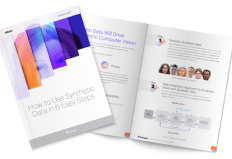Synthetic Data: The Complete Guide

What is Synthetic Data?
Synthetic data is any information manufactured artificially which does not represent events or objects in the real world. Algorithms create synthetic data used in model datasets for testing or training purposes. The synthetic data can mimic operational or production data and help train machine learning (ML) models or test out mathematical models.
Synthetic data offers several important benefits: it minimizes the constraints associated with the use of regulated or sensitive data, it can be used to customize data to match conditions that real data does not allow, and it can be used to generate large training datasets without requiring manual labeling of data.
This is part of an extensive series of guides about machine learning.
In This Article
Why Is Synthetic Data So Important?
Developers often require large, accurately labeled datasets when training AI models. Neural networks achieve higher accuracy when trained with more diverse data. However, it may be unrealistically time-consuming and expensive to collect and label these large datasets with thousands or even millions of objects.
Synthetic data can significantly bring down the cost of generating training data. For example, a training image that costs $5 if sourced from a data labeling service might cost as little as $0.05 if generated artificially.
In addition to lowering costs, synthetic data helps address privacy issues associated with potentially sensitive data sourced from the real world. It can also reduce bias compared to real data, which might not accurately reflect the full range of information about the real world. Synthetic data can provide greater diversity by including rare cases that represent realistic possibilities but may be difficult to source from authentic data.
Advantages of Synthetic Data
Data scientists shouldn’t mind if the data they use is authentic or synthetic, as long as it represents accurate patterns, is balanced, unbiased, and high quality. Synthetic data allows for enrichment and optimization, which allows data scientists to unlock several advantages:
- Data quality – in addition to being complicated and expensive to collect, real-world data is often full of errors, containing inaccuracies or representing a bias that may affect the quality of a neural network. Synthetic data ensures higher data quality, balance, and variety. Artificially-generated data can automatically fill in missing values and apply labels, enabling more accurate predictions.
- Scalability – machine learning requires massive amounts of data. It is often difficult to obtain relevant data on the necessary scale for training and testing a predictive model. Synthetic data helps fill in the gaps, supplementing real-world data to achieve a larger scale of inputs.
- Ease of use – synthetic data is often simpler to generate and use. When collecting real-world data, it is often necessary to ensure privacy, filter out errors, or convert data from disparate formats. Synthetic data eliminates inaccuracies and duplicates and ensures all data has a uniform format and labeling.
What Is a Synthetic Dataset?
A synthetic dataset is a dataset containing computer-generated data rather than real-word records. A major use for synthetic datasets is to provide robust, versatile data sufficient for ML training purposes.
Synthetic data must have specific properties to be useful for machine learning models like classification algorithms. A synthetic dataset may contain binary, numerical, categorical data, or unstructured data like images and video. It is important to control the random processes that generate data based on statistical distributions or generative models, to ensure that the result is sufficiently diverse, yet still realistic.
Synthetic data should be customizable. For example, it may be useful to adjust the degree of class separation to simulate harder or easier classification problems. On the other hand, other tasks like regression may benefit from generating data using non-linear processes.
What Are the Use Cases for Synthetic Data?
Synthetic data should accurately represent the original data it augments. High-quality synthetic data can serve as a substitute for actual sensitive production data in a non-production environment (i.e., training, testing, analytics, development, etc.).
Synthetic data also helps data scientists comply with data privacy regulations such as HIPAA, GDPR, CCPA, and CPA. Synthetic data is ideal for safely using sensitive datasets for training or testing purposes. Businesses can extract insights from such data without impacting privacy compliance.
Typical use cases for synthetic data include:
- Testing —synthetic test data is easier to generate than rule-based test data and provides flexibility, scalability, and realism. This data is essential for data-driven testing and software development.
- AI/ML model training —AI model training increasingly relies on synthetic data. Data synthesis can augment real data and upsample rarer events or patterns, enabling the algorithm to train more effectively. Synthetic training data typically performs better than real-world data and is crucial for building high-quality AI models.
- Governance – synthetic data helps remove biases present in real-world data. Synthetic data is also useful for stress-testing an AI model with data points that rarely occur in the real world. Synthetic data is essential for explainable AI and provides insights into how models behave.




























